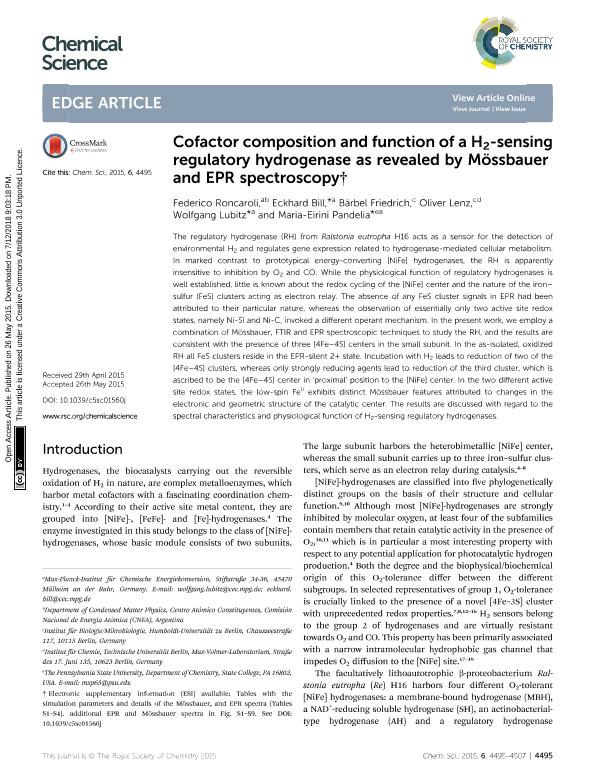Mostrar el registro sencillo del ítem
dc.contributor.author
Roncaroli, Federico

dc.contributor.author
Bill, Eckhard
dc.contributor.author
Friedrich, Bärbel
dc.contributor.author
Lenz, Oliver
dc.contributor.author
Lubitz, Wolfgang
dc.contributor.author
Pandelia, Maria Eirini
dc.date.available
2018-07-12T20:25:13Z
dc.date.issued
2015-05
dc.identifier.citation
Roncaroli, Federico; Bill, Eckhard; Friedrich, Bärbel; Lenz, Oliver; Lubitz, Wolfgang; et al.; Cofactor composition and function of a H 2 -sensing regulatory hydrogenase as revealed by Mössbauer and EPR spectroscopy; Royal Society of Chemistry; Chemical Science; 6; 8; 5-2015; 4495-4507
dc.identifier.issn
2041-6539
dc.identifier.uri
http://hdl.handle.net/11336/51940
dc.description.abstract
The regulatory hydrogenase (RH) from Ralstonia eutropha H16 acts as a sensor for the detection of environmental H2 and regulates gene expression related to hydrogenase-mediated cellular metabolism. In marked contrast to prototypical energy-converting [NiFe] hydrogenases, the RH is apparently insensitive to inhibition by O2 and CO. While the physiological function of regulatory hydrogenases is well established, little is known about the redox cycling of the [NiFe] center and the nature of the iron–sulfur (FeS) clusters acting as electron relay. The absence of any FeS cluster signals in EPR had been attributed to their particular nature, whereas the observation of essentially only two active site redox states, namely Ni-SI and Ni-C, invoked a different operant mechanism. In the present work, we employ a combination of Mössbauer, FTIR and EPR spectroscopic techniques to study the RH, and the results are consistent with the presence of three [4Fe–4S] centers in the small subunit. In the as-isolated, oxidized RH all FeS clusters reside in the EPR-silent 2+ state. Incubation with H2 leads to reduction of two of the [4Fe–4S] clusters, whereas only strongly reducing agents lead to reduction of the third cluster, which is ascribed to be the [4Fe–4S] center in ‘proximal’ position to the [NiFe] center. In the two different active site redox states, the low-spin FeII exhibits distinct Mössbauer features attributed to changes in the electronic and geometric structure of the catalytic center. The results are discussed with regard to the spectral characteristics and physiological function of H2-sensing regulatory hydrogenases.
dc.format
application/pdf
dc.language.iso
eng
dc.publisher
Royal Society of Chemistry

dc.rights
info:eu-repo/semantics/openAccess
dc.rights.uri
https://creativecommons.org/licenses/by-nc-sa/2.5/ar/
dc.subject
Regulatory Hydrogenase
dc.subject
Pulse Epr
dc.subject
Mössbauer
dc.subject
Fes Clusters
dc.subject.classification
Otras Ciencias Biológicas

dc.subject.classification
Ciencias Biológicas

dc.subject.classification
CIENCIAS NATURALES Y EXACTAS

dc.title
Cofactor composition and function of a H 2 -sensing regulatory hydrogenase as revealed by Mössbauer and EPR spectroscopy
dc.type
info:eu-repo/semantics/article
dc.type
info:ar-repo/semantics/artículo
dc.type
info:eu-repo/semantics/publishedVersion
dc.date.updated
2018-07-12T19:05:41Z
dc.journal.volume
6
dc.journal.number
8
dc.journal.pagination
4495-4507
dc.journal.pais
Reino Unido

dc.description.fil
Fil: Roncaroli, Federico. Max Planck Institut für Chemische Energiekonversion; Alemania. Comisión Nacional de Energía Atómica. Centro Atómico Constituyentes; Argentina
dc.description.fil
Fil: Bill, Eckhard. Max Planck Institut für Chemische Energiekonversion; Alemania
dc.description.fil
Fil: Friedrich, Bärbel. Universität zu Berlin; Alemania
dc.description.fil
Fil: Lenz, Oliver. Universität zu Berlin; Alemania. Technische Universität Berlin; Alemania
dc.description.fil
Fil: Lubitz, Wolfgang. Max Planck Institut für Chemische Energiekonversion; Alemania
dc.description.fil
Fil: Pandelia, Maria Eirini. Max Planck Institut für Chemische Energiekonversion; Alemania. State University of Pennsylvania; Estados Unidos
dc.journal.title
Chemical Science
dc.relation.alternativeid
info:eu-repo/semantics/altIdentifier/doi/http://dx.doi.org/10.1039/C5SC01560J
dc.relation.alternativeid
info:eu-repo/semantics/altIdentifier/url/http://pubs.rsc.org/en/content/articlelanding/2015/sc/c5sc01560j
Archivos asociados
